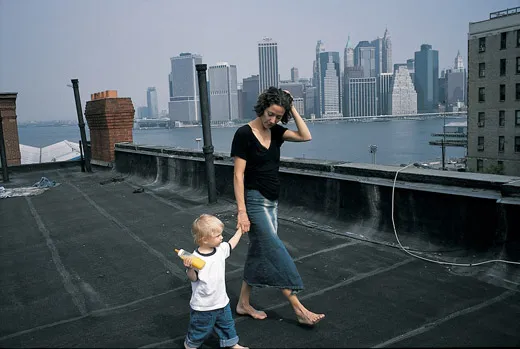September 11 From a Brooklyn Rooftop
Photographer Alex Webb captured a moment that showed, he says, the “continuity of life in the face of disaster”
/https://tf-cmsv2-smithsonianmag-media.s3.amazonaws.com/filer/Brooklyn-Rooftop-September-11-631.jpg)
Alex Webb and Jenna Piccirillo were strangers when he photographed her with her 3-month-old son, Vaughan, on September 11, 2001. They were on the roof of the apartment building in which she was staying in Brooklyn Heights. Piccirillo, then 31 and a graduate student in interior design at the Pratt Institute in Brooklyn, was about to move to Long Island and had been on the roof only the night before to watch the sunset. "We took some video because the cityscape seemed especially magnificent as we were sort of saying our good-byes to the city and looking forward to our future in the suburbs," she recalls.
On the morning of the 11th, Piccirillo woke to a crack of what she supposed was thunder. When she opened her eyes to sunshine and blue sky, she thought it was going to be a "perfect day for a rainbow," she says. She carried Vaughan downstairs to a deli for her morning coffee. "The clerk and a customer were talking about the second plane hitting," Piccirillo remembers. She thought they were joking, but soon realized something horrible had indeed happened. "I wanted to see it," she says. "I grabbed hold of my son, I took my coffee, and climbed up to the roof."
A crowd was already gathering on the roof. "Not knowing what was going to happen next was terrifying," she remembers. "Was the world going to end?" People were trying to make cellphone calls, usually to no avail. Rumors circulated. Fears grew. People speculated wildly about the identity of the attackers. "The conversations were sort of background sound to me," Piccirillo says, recalling how she silently, raptly watched events unfold. A girl suggested the towers would crumble, but Piccirillo felt certain she was wrong.
Webb, a veteran photographer represented by the Magnum agency, and his wife, Rebecca Norris Webb, who is also a photographer, live in the Park Slope neighborhood of Brooklyn. At the time of the attacks, he was out buying groceries. He overheard passersby talking about a plane crashing into the World Trade Center. He ran home and turned on the television. He and Rebecca began packing their cameras.
The subway was shut down, so they rented a car and drove toward the Brooklyn Bridge, which was closed. They parked and continued on foot. A woman leaving an apartment building called out, asking if they wanted to see the city from the roof. They went up and found a crowd of people looking toward Manhattan. The Webbs took some pictures there and walked from rooftop to rooftop, looking for a vantage point. Then they saw Piccirillo. It was sometime after 11 A.M. when Webb took her picture. He says he was struck by the "sense of the continuity of life in the face of disaster."

The concentration of reporters, photographers and news organizations in New York City made the events of September 11 probably the most thoroughly covered catastrophe ever. Other photographs that Webb took that day would be published around the world, but the picture of Jenna and Vaughan would become his best known. One night Piccirillo was watching television with a friend. "Jenna," the friend said, "Look, it’s you and Vaughan!" It was the first time she had seen the photograph. It has appeared many times since—on "60 Minutes II" and in Time, in newspapers and in books, in the United States and abroad. It was published in New York September 11, a book by Magnum photographers. Piccirillo is puzzled by her brush with media attention: "I think, my gosh, while I am grateful to have been coincidentally part of history, why our photo?"
Max Kozloff, a photographer and art critic, writes in the journal Parnassus: Poetry in Review that Webb’s photograph of Piccirillo and son "displays a wonderfully incongruous tendency to show that life has its own purposes, independent of any scheme, and despite the heart-stopping urgency of the moment." Kozloff adds, "The focus on a local and tender episode renders the climactic event as hardly noticed background." Of course, as smoke and dust covered Lower Manhattan that morning, parents everywhere were paying special attention to their children. History is a tissue of such tender episodes, if also an imperfect record of them.
This past May, Piccirillo and Webb returned to the same roof for another photograph. Webb, 51, is best known for his enigmatic and often surprising reportage, particularly from Latin America and the Caribbean. He rarely returns to a place he has photographed and almost never "stages" a picture. "Most of what I do is about going and finding something," he says, "and in this instance I was bringing something to the situation." Piccirillo was proud and excited to go back, "not somber, as one might expect," she remembers.
Since their first, chance encounter, Webb has completed his fifth book, Crossings: Photographs from the U.S.-Mexico Border, to be published this fall. Vaughan is now 2 1/2, and Piccirillo works with a firm specializing in school architecture. They live in Patchogue, Long Island. She hasn’t decided when she’ll discuss the picture with Vaughan. "I have shown him the photograph, but I don’t want him to know the details right now," she says. "I don’t plan to shelter him forever, but for now this is what I do."